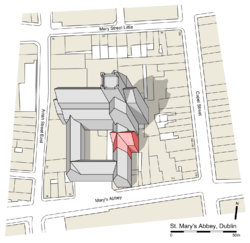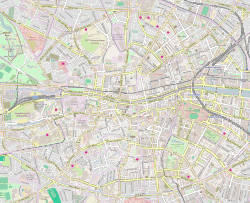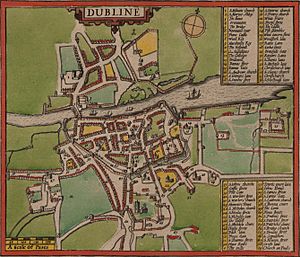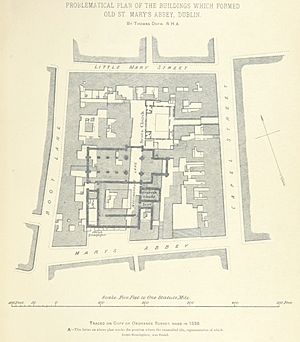St. Mary's Abbey, Dublin facts for kids
| Mainistir Mhuire | |

St Marys' Abbey - axonometric model on urban quarter
|
|
| Monastery information | |
|---|---|
| Order | Order of Saint Benedict (846–1139) Congregation of Savigny (1139–1147) Cistercian Order (1147–1539) |
| Established | AD 846 |
| Disestablished | 1539 |
| Dedicated to | Mary, mother of Jesus |
| Diocese | Dublin |
| People | |
| Founder(s) | Máel Sechnaill mac Máele Ruanaid |
| Abbot | Walter Champfleur (c.1468-99), John Orum (1499-?) |
| Architecture | |
| Functional Status | Museum |
| Heritage designation | National Monument |
| Style | Cistercian |
| Site | |
| Location | Abbey Street, Dublin, Ireland |
| Coordinates | 53°20′51″N 6°16′09″W / 53.3475°N 6.269167°W |
| Public access | yes |
| Official name | St. Mary's Abbey |
| Reference no. | 401 |
St. Mary's Abbey (Irish: Mainistir Mhuire) was once a very important Cistercian abbey in Dublin, Ireland. It was located near where Abbey Street and Capel Street meet today. The abbey owned a lot of land, stretching from the area called Oxmanstown all the way along the River Liffey to the sea. It also had large properties in other parts of Ireland. St. Mary's Abbey was one of several "liberties" in Dublin. This meant it had special control over its own lands, almost like a small independent area.
Contents
The Abbey's Long History
St. Mary's Abbey was founded way back in 846 AD. It was started by an Irish king named Máel Sechnaill mac Máele Ruanaid. At first, it was a Benedictine monastery. But in 1139, it was given to a different group of monks called the Congregation of Savigny. A few years later, in 1147, these monks joined the Cistercian order. The abbey remained Cistercian until it closed down.
Challenges and Changes
In 1303, a big fire destroyed much of the abbey and its church. But the monks rebuilt it! Sadly, many important city records and court documents stored there were lost in the fire. Even with this setback, St. Mary's Abbey was one of the biggest and richest abbeys in Ireland. It had special rights, like being able to claim goods from shipwrecks along the Dublin coast.
In 1316, the Mayor of Dublin, Robert de Nottingham, attacked the abbey. He suspected that the Earl of Ulster, Richard Óg de Burgh, who was visiting the abbey, was helping Edward Bruce. Bruce was an enemy who was marching towards Dublin. Some of de Burgh's men were killed, and the Earl was captured. The monks were also suspected of helping Bruce, so the abbey was badly damaged.
Important People at the Abbey
In the 1400s, a man named Walter Champfleur became the Abbot of St. Mary's. He was in charge for over 30 years! He was an important political figure and advised a powerful Earl. People remembered him as a wise and learned man.
A famous event happened at the abbey in 1534. Silken Thomas, a young Irish nobleman, started a rebellion against the English King here. He dramatically threw down his Sword of State in the Chapter House, showing he was no longer loyal.
From Abbey to Arsenal
In 1539, the King of England decided to close down many monasteries, including St. Mary's Abbey. This was called the Dissolution of the Monasteries. The abbey's buildings were then used as an arsenal, a place to store weapons. Parts of it were also used as a quarry, meaning stones were taken from it for other buildings. The large lands that the monks once owned were later rented out to people who wanted to build homes or businesses.
The Abbey Becomes a Home
In 1619, King James I of England gave the abbey and its lands to Sir Gerald Moore. His family, the Moores, used the abbey as their home in Dublin for many years. One of them, Henry Moore, 1st Earl of Drogheda, even built a large house on what is now O'Connell Street. He also helped develop nearby streets like Henry, Moore, and Earl streets.
Later, in 1676, stones from the abbey's ruins were used to build Essex Bridge. This bridge is now called Grattan Bridge.
Other Uses of the Abbey Site
Over time, different groups used parts of the old abbey land.
- Churches: Two non-conformist chapels (churches not part of the main Church of Ireland) were built on the site. One of these became the Abbey Presbyterian Church that is now on Parnell Square.
- Synagogue: In 1836, a Jewish congregation bought one of the former chapels on the abbey site. This became the Mary's Abbey Synagogue. It operated there until 1892.
- Cemetery: The old monastic lands of Glasnevin, which once belonged to the abbey, were bought around 1832. These lands were used to create what is now Glasnevin Cemetery, a very famous burial ground.
Rediscovering the Abbey
For many years, the abbey was mostly forgotten and buried. In the 1880s, an amateur archaeologist rediscovered parts of it, about 7 feet (2 meters) underground, beneath a bakery! His findings were shared by John Thomas Gilbert. Today, you can still see parts of the old walls. The Chapter House, where important meetings happened, is usually open to visitors. You go down a stone staircase to see it.
Recent Discoveries
In 2023, during excavations for a new hotel, the remains of over 100 skeletons were found on the site. These skeletons date back to the early 11th century, giving us more clues about the people who lived near the abbey long ago.
Also, in 2014, Trinity College Dublin bought a very old handwritten book that was made at St. Mary's Abbey in 1304. It cost almost €250,000!
See also
- List of abbeys and priories in Ireland (County Dublin)




